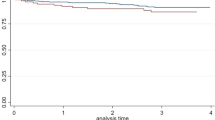Abstract
Cerebral white matter hyperintensities (WMH) are a consequence of cerebral small vessel disease. Statins have been shown to reduce recurrent stroke among patients with various stroke subtypes, including lacunar stroke, which also arises from small vessel disease. In this study, we investigated the hypothesis that prestroke statin use would reduce the progression of WMH and/or cognitive decline among stroke patients with confluent WMH. Patients (n = 100) were participants of the VITAmins To Prevent Stroke magnetic resonance imaging substudy. All patients had confluent WMH on magnetic resonance imaging at baseline. Eighty-one patients completed the 2-year follow-up. We assessed general cognition and executive function using the mini-mental state examination and Mattis dementia rating scale–initiation/perseveration subscale, respectively. We compared the change in volume of WMH and cognition between prestroke statin use and prestroke nonstatin use groups. We also evaluated the effects of prestroke statin use on incident lacunes and microbleeds. The prestroke statin use group (n = 51) had less WMH volume progression (1.54 ± 4.52 cm3 vs 5.01 ± 6.00 cm3, p = 0.02) compared with the prestroke nonstatin use group (n = 30). Multivariate linear regression modeling identified prestroke statin use as an independent predictor of WMH progression (β = –0.31, p = 0.008). Prestroke statin use was also associated with less decline (Mattis dementia rating scale–initiation/perseveration subscale; β = 0.47, p = 0.001). No association was observed with changes in mini-mental state examination scores. There were no between group differences on incident lacunes or incident microbleeds. Prestroke statin use may reduce WMH progression and decline in executive function in stroke patients with confluent WMH.
Similar content being viewed by others

References
Pantoni L. Cerebral small vessel disease: from pathogenesis and clinical characteristics to therapeutic challenges. Lancet Neurol 2010;9:689-701.
Debette S, Markus HS. The clinical importance of white matter hyperintensities on brain magnetic resonance imaging: systematic review and meta-analysis. BMJ 2010;341:c3666.
Schmidt R, Petrovic K, Ropele S, Enzinger C, Fazekas F. Progression of leukoaraiosis and cognition. Stroke 2007;38:2619-2625.
Schmidt R, Scheltens P, Erkinjuntti T, et al. White matter lesion progression: a surrogate endpoint for trials in cerebral small-vessel disease. Neurology 2004;63:139-144.
van Dijk EJ, Prins ND, Vrooman HA, et al. Progression of cerebral small vessel disease in relation to risk factors and cognitive consequences: Rotterdam Scan study. Stroke 2008;39:2712-2719.
Dufouil C, Chalmers J, Coskun O, et al. Effects of blood pressure lowering on cerebral white matter hyperintensities in patients with stroke: the PROGRESS (Perindopril Protection Against Recurrent Stroke Study) Magnetic Resonance Imaging Substudy. Circulation 2005;112:1644-1650.
Bernick C, Katz R, Smith NL, et al. Statins and cognitive function in the elderly: the Cardiovascular Health Study. Neurology 2005;65:1388-1394.
Amarenco P, Benavente O, Goldstein LB, et al. Results of the Stroke Prevention by Aggressive Reduction in Cholesterol Levels (SPARCL) trial by stroke subtypes. Stroke 2009;40:1405-1409.
ten Dam VH, van den Heuvel DM, van Buchem MA, et al. Effect of pravastatin on cerebral infarcts and white matter lesions. Neurology 2005;64:1807-1809.
B vitamins in patients with recent transient ischaemic attack or stroke in the VITAmins TO Prevent Stroke (VITATOPS) trial: a randomised, double-blind, parallel, placebo-controlled trial. Lancet Neurol 2010;9:855-865.
Wahlund LO, Barkhof F, Fazekas F, et al. A new rating scale for age-related white matter changes applicable to MRI and CT. Stroke 2001;32:1318-1322.
Mok V, Xiong Y, Wong KK, et al. Predictors for cognitive decline in patients with confluent white matter hyperintensities. Alzheimer Dement 2012;8:S96-S103.
Sacco RL, Adams R, Albers G, et al. Guidelines for prevention of stroke in patients with ischemic stroke or transient ischemic attack: a statement for healthcare professionals from the American Heart Association/American Stroke Association Council on Stroke: co-sponsored by the Council on Cardiovascular Radiology and Intervention: the American Academy of Neurology affirms the value of this guideline. Circulation 2006;113:e409-e449.
Cavalieri M, Schmidt R, Chen C, et al. B vitamins and magnetic resonance imaging-detected ischemic brain lesions in patients with recent transient ischemic attack or stroke: the VITAmins TO Prevent Stroke (VITATOPS) MRI-substudy. Stroke 2012;43:3266-3270.
Schmidt R, Enzinger C, Ropele S, Schmidt H, Fazekas F. Progression of cerebral white matter lesions: 6-year results of the Austrian Stroke Prevention Study. Lancet 2003;361:2046-2048.
Plummer D. DispImage: a display and analysis tool for medical images. Rev Neuroradiol 1992;5:489-495.
Schneider JA. Brain microbleeds and cognitive function. Stroke 2007;38:1730-1731.
Chiu HFK, Kee HC, Chung WS, Kwong PK. Reliability and validity of the Cantonese version of Mini-mental state examination – a preliminary study. J Hong Kong Coll Psychiatry 1994;4(Suppl. 2):25-28.
Chan AS, Choi MK, Salmon DP. The effects of age, education, and gender on the Mattis Dementia Rating Scale performance of elderly Chinese and American individuals. J Gerontol B Psychol Sci Soc Sci 2001;56:P356-P363.
Davignon J. Beneficial cardiovascular pleiotropic effects of statins. Circulation 2004;109(23 Suppl. 1):III39-43.
Wardlaw JM, Sandercock PA, Dennis MS, Starr J. Is breakdown of the blood-brain barrier responsible for lacunar stroke, leukoaraiosis, and dementia? Stroke 2003;34:806-812.
Mok VC, Wong A, Lam WW, et al. Cognitive impairment and functional outcome after stroke associated with small vessel disease. J Neurol Neurosurg Psychiatry 2004;75:560-566.
Mok V, Wong KK, Xiong Y, et al. Cortical and frontal atrophy are associated with cognitive impairment in age-related confluent white-matter lesion. J Neurol Neurosurg Psychiatry 2011;82:52-57.
Acknowledgment
This work was supported by a 2005/2006 Earmarked Grant CUHK 4317/04 M.
Required Author Forms
Disclosure forms provided by the authors are available with the online version of this article.
Conflict of Interests
None.
Author information
Authors and Affiliations
Corresponding author
Rights and permissions
About this article
Cite this article
Xiong, Y., Wong, A., Cavalieri, M. et al. Prestroke Statins, Progression of White Matter Hyperintensities, and Cognitive Decline in Stroke Patients with Confluent White Matter Hyperintensities. Neurotherapeutics 11, 606–611 (2014). https://doi.org/10.1007/s13311-014-0270-5
Published:
Issue Date:
DOI: https://doi.org/10.1007/s13311-014-0270-5



